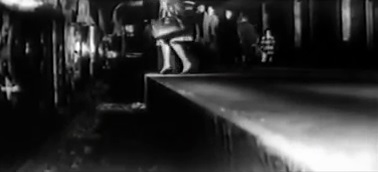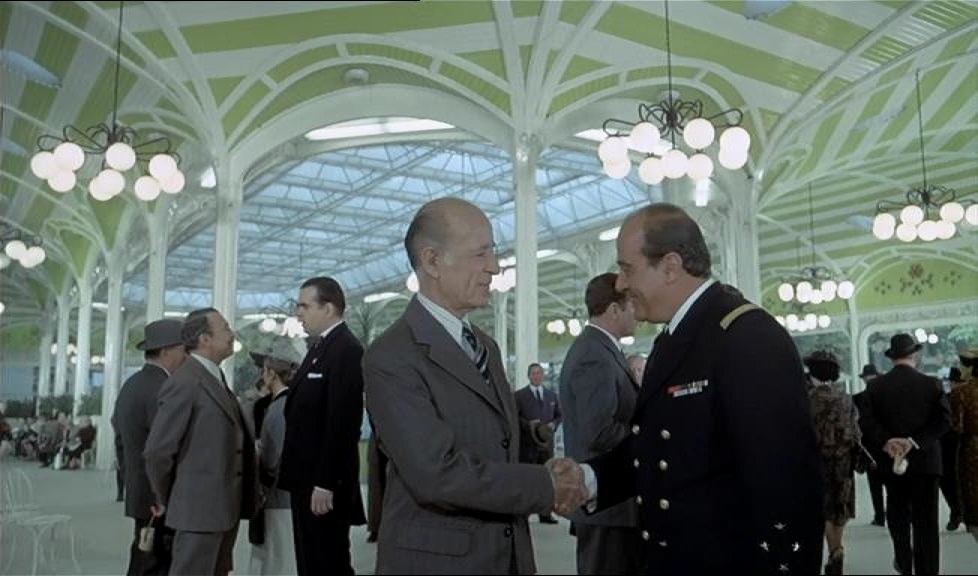The Sleeping Car Murder

A lottery winner
on the train from Marseilles, then others in the compartment around Paris.
A key film for an
understanding of Z, practically
summed up in Rosenberg’s The
Laughing Policeman (cp. The Alphabet Murders, dir. Frank Tashlin). “The
perfect crime” is from Hitchcock’s Rope and Fleischer’s Compulsion.
A brilliant,
virtuosic masterpiece like a bookend to Clouzot’s Quai des Orfèvres. The
excellent New York dub has Signoret.
Bosley Crowther of the New York Times (who saw it with subtitles), “it doesn’t make sense.” Tom Milne (Time Out), “straightforward detective thriller”. TV Guide, “somewhat impenetrable mystery... intriguing, highly entertaining”. Film4, “pacey movie ends with an exciting chase.” Don Druker (Chicago Reader), “before he went all political and right-thinking.” Catholic News Service Media Review Office, “it affects a benign attitude toward premarital sex and unnecessarily graphic treatment of several erotic sequences... morally offensive”. Hal Erickson (All Movie Guide), “unlikely climax is the only sore point of this otherwise well-wrought mystery.” Halliwell’s Film Guide, “long-winded whodunnit with an unlikely solution.”
Z
Two homosexual
thugs kill the lecturer at a peace rally, they’re working for the
government, he’s an “Olympic athlete, university professor, medical
doctor, and senator”. The case is treated as a traffic accident, an
examining magistrate gets to the Kafkaesque bottom of it.
Costa-Gavras has
the superb grasp of confrontational politics in rallies and parades that is
required.
Indictments and
light sentences are handed down, a military coup sweeps aside a laundry list of
cultural items including the title, “he lives” in Greek.
L’aveu
A Czech show
trial, in 1952.
Jorge Semprun has
the screenplay from the source, the hero fought in the Spanish Civil War, and
then in the French Resistance.
Released, years
later, amid executions, in exile, recounting the tale, writing the memoir.
Prague ’68,
student slogan, “Wake Up Lenin! It’s All Gone Crazy!”
État de siège
The front of the
Cold War that is South America. The nation’s
revolutionary leader looks down on the proceedings in portraits.
Critics were
mostly shocked.
Section spéciale

Vichy is a spa,
members of the government take the cure. Young
Communists march in Paris and are shot, others decide to kill occupying Germans
in uniform.
Beautiful in
August, the city. At the seat of power, retroactive
laws and the Hotel Thermal.
The astute joke
is from The Bicycle Thief (dir.
Vittorio De Sica), the unstated precedent is Paths of Glory (dir. Stanley Kubrick).
|
Monsieur le Maréchal,
il y a un devoir pour les morts qui est de ressusciter. |
Roger Ebert (Chicago Sun-Times), “doesn’t
have Costa-Gavras’ customary touch of melodramatic outrage.” Time Out,
“one
of Costa-Gavras’ glossy political melodramas.” Hal Erickson (All Movie Guide),
“the
parallels to contemporary political persecution are inescapable.”
Missing
The material is
treated with ability, self-effacement and, as befits a tale of hidden agendas, one
of its own for artistic measure. What’s more interesting, the dramatic
structure, the cinematic handling or the meditation underneath the whole thing?
The small group
of Americans in Chile during the coup are represented in their own terms and from
their viewpoint, with no outside reference point but the military takeover seen
on the streets in terms prepared by Bergman and Resnais. Charles Horman (John
Shea) is a curly-haired gimlet-eyed Ivy League liberal with a smile. His crowd
are instantly recognizable, and so are their emotions. Mrs. Horman (Sissy
Spacek) is caught out after curfew, she hides in a doorway and sees a white
horse running down the avenue followed by soldiers in a jeep firing in the air.
It’s the persistent quality of polarized emotion tingeing events with
unreality that Costa-Gavras conveys with the utmost objectivity and dispassion.
“Paint not the thing, but the effect it produces,” Mallarmé says.
Truly, these are
monstrous events (bodies, arrests, etc.). Costa-Gavras steels himself against
it all to let it transpire on film as it was perceived.
Horman vanishes,
his apartment is wrecked. Ed Horman (Jack Lemmon) flies down to get him.
He’s a businessman, a man who does things and pays wages, a somewhat
dusty taxpayer and maybe one of the Silent Majority. He finds out from his
son’s friends this that and the other thing about Charles’ work as
a freelance journalist, the arrest of two colleagues, etc. Charles kept a
notebook. Over lunch with these kids, consulting the notebook, interviewing
State Department officials and others, Mr. Horman pieces it together, and
Costa-Gavras films what he learns as flashbacks (in one instance as Rashomon
replays). The amazing thing is, while fleeing the city, Charles stumbled onto
the American military involvement in the coup. These scenes are brief, an
incidental conversation in a restaurant, a visit poolside, and they have very
much the air of Frankenheimer’s Seven Days in May as rather
surprised American officers and officials find themselves talking to an
innocent abroad while their ops are succeeding.
After talking on
the telephone in his hotel room, Mr. Horman is so agitated he hardly notices an
earthquake, but it gets worse and everybody heads for the lobby like a scene in
a Hollywood disaster film, and that film is The Last Days of Pompeii (dir. Ernest B. Schoebsack),
the symbolic force of which prepares the ending. In a powder blue (or Federal
blue) room, he’s confronted with the official American response to his
son’s death. In the second part of this, he and Charles’ wife are
seen off at the airport, and he gives the American officials there a piece of
his mind. The camera watches the father and daughter-in-law walk down the
corridor to the plane with a palpable sense that witness has been borne. The
last shot is of the crate containing Charles’ body.
Hanna K.
The one about the
Frenchman, the Israeli, and the Palestinian, who run into an American lawyer (cf. Miller’s Lonely Are the Brave).
“A large,
soggy dud” (Vincent Canby, New York
Times).
“Two hours
of damp didacticism” (Dave Kehr, Chicago Reader).
“The
strength of its political message overrides its aesthetic problems”
(Edward Said, Village Voice).
The screenplay is
signed Franco Solinas, a satire of Semprun. William Weaver is credited with
“English continuity”, Gideon Amir “production services in
Israel” and “lawyer court”.
Betrayed
Costa-Gavras has
the layout of the plan, a schematic understanding he doesn’t pussyfoot
around. It governs any and all such situations of private grievance with ZOG,
the “Zionist Occupation Government”, under any political flag
whatsoever. Thus, he gives you a KKK rally around a burning cross with Nazi
battle flag, and concludes with a political assassination that has idealist
overtones. Counter to all of this, there is the FBI, cold, doubtful, hard men.
In order to accomplish his purpose, Costa-Gavras has to have the poetic
element, and that’s Debra Winger all the way undercover with a Rita
Tushingham face she throws on for mobility in tight situations.
The realism of
Costa-Gavras is the surface portraiture that tells the great tale. When the
gang robs a bank and Winger is forced to shoot a lurking security guard, the
look on her face afterward through her camouflage veil is one of those things
Garbo used to do. Just before the end, Costa-Gavras dissolves from this face to
the farmlands being watered or picked, and Clarence Brown couldn’t have
done it any better.
Richard Libertini
plays the radio talk show host so insolent he drives a Citroën. A death squad
circles around his car in a parking structure (Costa-Gavras is a great one for
the POV insert) and guns him down. The upper reaches of the gang are capable of
choppering intelligence to the “front.” Such films as The Domino
Principle (dir. Stanley Kramer) and The Package (dir. Andrew Davies)
are related.
Winger’s
showdown with her lover (Tom Berenger) is just the masterpiece called for.
He’s about to accomplish the assassination, her cover has been blown, and
they’re close enough to see each other in the face.
Costa-Gavras made
this film as clean and beautiful as possible, and still there is no relation at
all between it and the reviews, so the question arises if our critics know
anything except the fine art of holding down a job without qualifications of
any kind whatsoever.
Mad City
The key to the
whole film is the accuracy of the children’s performance, the script
gives indications of America as a prison enlivened by television (and to that
extent there is more than a nuance of Lumet’s The Hill), the real
view is more particular and detailed, juvenile hostages in the Natural History
Museum basically untroubled.
Television news
is taken apart from top to bottom, it is simply not enough to satisfy any
artist for him to apply the conventional and sufficient word
“bullshit” and be done with it.
Billy
Wilder’s Ace in the Hole is the evident groundwork (suggested by
the last shot), William Wellman’s Magic Town is the transformation
of the global city.
The top of the
industry isn’t the reigning face nor his controlling junior executives
but the absconding CEO in the first scene.
Amid the
self-serving misunderstandings that comprise the plot is a satire of Dan
Rather’s “what did you see, what did you feel” at the San
Francisco freeway collapse, and his comeuppance on national television after
the Columbia disaster. Mia Kershner contributes an impression of Joan Bennett
as the intern. Alan Alda has learned the inflections of the Evening News.
Travolta and Hoffman are a mirror of facets in all the bright lights.
Critics have
attested to the truth of it, Maslin in the New York Times by blaming the
public and the movies as well (a Time/Warner film).
Amen.
The story is so
curious that once again reviewers’ befuddlement may be overlooked. After
all, as the papal nuncio says, a Protestant Waffen-SS chemist specializing in
water purification and vermin extermination who appeals to the Pope on behalf
of the Jews? Gestapo subterfuge! He thinks we’re idiots, says the nuncio.
It’s more
than bureaucracy and red tape, it’s the Vatican position of deep
neutrality with a posture of condemnation for the Nazis and Stalin, recognizing
one as a power against the other, but it’s all talk in the film. The
world is what it is, the Jews are not in the picture.
Every point of
view is registered, they are all stated, hardly a Jew is seen, a few arrested
or in the boxcars or shepherded into the Vatican. It just doesn’t work
out, a lowly priest and the chemist can’t rise through it all and make
themselves heard. Maybe it’s God’s providence, who knows?
The Vatican has a
lousy organization, good by its lights, under the Nazi guns and who can believe
an SS man, anyway?
You can begin to
see the isolated problem put by Costa-Gavras, even if the critics blessedly
could not. The title acknowledges an historical fact.
The difference
between a successful opposition to euthanasia and this limited safeguarding of
Jews is put down to the passage of time and the course of the war, there is no
indictment to speak of, only the comparison of many speeding freight trains and
the snail’s-pace of rescue.
The
cinematography is especially beautiful throughout. Chomsky’s Holocaust and Clément’s Is Paris Burning? figure much of the
action, here a first eyewitness to the liquidations tries to get the word out
through the pulpit.